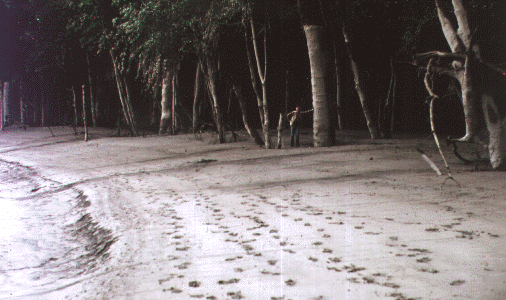

For geologists who study modern deposits, lahars may be defined in terms of visible characteristics of witnessed flows. The following definitions of lahar come from research geologists that study flows in action and their deposits: definitions of lahars from the U.S. Geological Survey. This USGS link also leads to definitions of other volcanic terms.
Common non-volcanic processes by which lahars and other debris flows form are by heavy rains falling upon loose debris or by loose debris becoming saturated with water from melting snow, glaciers or heavy rains (Osterkamp et al., 1986). Water-saturated material can move downhill like wet concrete when its internal strength is exceeded.
Internal resistance to flow results from (1) electrostatic forces causing cohesive resistance to flow arising from clay-water mixtures or (2) from friction caused by inertial interaction of large fragments (greater than medium silt-size) causing inertial resistance to flow or frictional resistance (cohesionless or density-modified grain flows; Lowe, 1982). The relative importance of these two causes of flow resistance depends upon the amount of admixed clay-size grains, a small amount (~5%) of which can cause major changes in flow behavior. Grains are supported in debris flows by mass effects caused by high concentration (e.g., cohesive strength, frictional strength, viscous resistance and dispersive pressure), and by turbulence and pore-fluid expulsion.
Debris flows consist of: (1) a continuous phase (matrix phase or fluid phase) composed of water mixed with particles <2 mm, and (2) a coarse-grained phase of large particles >2 mm (Fisher, 1971; Scott, 1988). Therefore, even with a continuum of grain sizes from clay to boulders, it is possible to conceptually consider mass properties of high concentration flows (e.g. viscosity, density and strength) without knowing the individual properties of the particles: the matrix phase can be considered to be the fluid that transports the large fragments, even though the large particles are part of the fluid. A coarse-grained debris flow can be most easily characterized by grain size parameters of the matrix phase, and matrix competence can be characterized by a measure of the largest fragments (e.g., the average of the five largest particles within a specified area, e.g. 1 square m). Complete analyses of coarse-grained lahar deposits containing boulders, cobbles and pebbles entail various methods of size determinations including wet or dry sieving of the sand-size and coarser parts of a sample (up to about 16 mm) and analysis of the silt- and clay-size fractions.
During downstream movement in water-rich environments, lahars may progressively mix with water and transform to hyperconcentrated flood flows. Hyperconcentrated flood flows lack the strength and cohesion of lahars, but can carry high sediment loads with fragments supported both by turbulence and particle interactions (Pierson and Scott, 1985; Scott, 1988; Smith, 1986). Such floods can move as far as 250 km or more down valleys, and because of their high loads, will impact an entire river system such as occurred at Mount St. Helens in 1980.
Costa, J.E. (1984) Physical geomorphology of debris flow. In Costa, J.E. & Fleischer, P.J, eds., Developments and applications of geomorphology, Berlin, Springer-Verlag, 268-317.
Fisher, R.V. (1971) Features of coarse-grained, high-concentration fluids and their deposits. J. sedim. Petrol. 41, 916-927.
Fisher, R.V. (1983) Flow transformations in sediment gravity flows. Geology 11, 273-274.
Fisher, R.V. (1984) Submarine volcaniclastic rocks. In Kokelaar, B.P. and Howells, M.F. (eds), Marginal basin geology: volcanic and associated sedimentary and tectonic processes in modern and ancient marginal basins. Spec. Publ. geol. Soc. London 16, 5-27.
Fisher, R.V. & Schmincke, H.-U. (1984) Pyroclastic Rocks. Springer-Verlag, Berlin, 472 pp.
Glicken, H., Meyer, W., & Sabol, M.A. (1989) Geology and ground-water hydrology of Spirit Lake Blockage, Mount St. Helens, Washington, with implications for lake retention. U.S. geological Survey Bull. 1789, 1-33.
Lowe, D.R. (1982) Sediment gravity flows: II. Depositional models with special reference to the deposits of high density turbidity currents. J. sedimen. Petrol. 52, 279-297.
Lowe, D.L., Williams, S.N., Leigh, H., Connor, C.B., Gemmell, J.B. & Stoiber, R.E. (1986) Lahars initiated by the 13 November 1985 eruption of Nevado del Ruiz, Colombia. Nature 324, 51-53.
Major, J.J. & Newhall, C.G. (1989) Snow and ice perturbation during historical volcanic eruptions and the formation of lahars and floods. Bull. Volcanol. 52, 1-27.
Osterkamp, W.R., Hupp, C.R. & Blodgett, J.C. (1986) Magnitude and frequency of debris flows, and areas of hazard on Mount Shasta, Northern California. U.S. geol. Survey Professional Paper 1396-C, 1-21.
Pierson, T.C. & Scott, K.M. (1985) Downstream dilution of a lahar: transition from debris flow to hyperconcentrated streamflow. Water Resources Research 21, 1511-1524.
Scott, K.M. (1988) Origins, behavior, and sedimentology of lahars and lahar-runout flows in the Toutle-Cowlitz system. U.S. geol. Survey Prof. Paper, 1447-A, 1-74.
Smith, G.A. (1986) Coarse-grained nonmarine volcaniclastic sediment: Terminology and depositional process. Bull. geol. Soc. Amer. 97, 1-10.